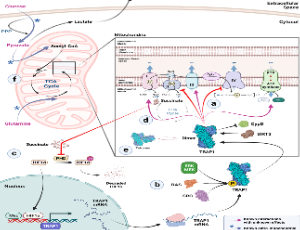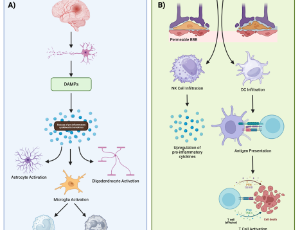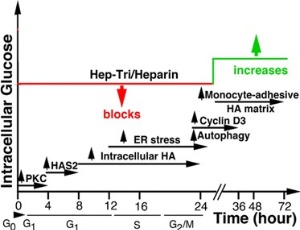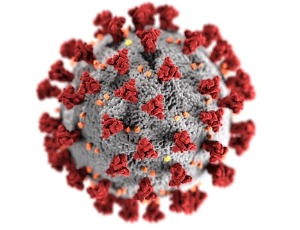Loading
Journal of Cellular Immunology
ISSN: 2689-2812

2023
Volume 5, Issue 3, p57-96
Articles published in this issue are Open Access and licensed under Creative Commons Attribution License (CC BY NC) where the readers can reuse, download, distribute the article in whole or part by mentioning proper credits to the authors.
The Regulation Impact of Naringenin-loaded Chitosan Nanoparticles on Succinate Dehydrogenase Activity in Cancer Cells
Eman M. Ragab, Abeer A. Khamis, Doaa M. El Gamal, Tarek M. Mohamed
Oxidative phosphorylation dysregulation (OXPHOS) has been demonstrated to be essential for the development of cancer. Therefore, it may be argued that chaperone and deacetylase activities modulate OXPHOS activity. For instance, a complicated network of interactions connects a cell’s bioenergetic features and neoplastic potential through the imbalance of sirtuin 3 (SIRT3) and succinate dehydrogenase (SDH) enzymatic activity in mitochondria.
J Cell Immunol, 2023, Volume 5, Issue 3, p57-64 | DOI: 10.33696/immunology.5.169
Immunologic Implications for Stroke Recovery: Unveiling the Role of the Immune System in Pathogenesis, Neurorepair, and Rehabilitation
Grace Hey, Siya Bhutani, Maxwell G. Woolridge, Aashay Patel, Anna Walls, Brandon Lucke-Wold
Stroke is a debilitating neurologic condition characterized by an interruption or complete blockage of blood flow to certain areas of the brain. While the primary injury occurs at the time of the initial ischemic event or hemorrhage, secondary injury mechanisms contribute to neuroinflammation, disruption of the blood-brain barrier (BBB), excitotoxicity, and cerebral edema in the days and hours after stroke.
J Cell Immunol, 2023, Volume 5, Issue 3, p65-81 | DOI: 10.33696/immunology.5.170
Non-reducing End of Heparin Tri-saccharide is a Scavenger Tool to Detoxify the Glucose Toxicity in Diabetes
Andrew Jun Wang, Aimin Wang, Vincent Charles Hascall
Heparin is a highly sulfated, hence highly polyanionic, glycosaminoglycan with a repeating disaccharide that contains a hexuronic acid, and it has been used as an anticoagulant clinically for more than half a century. Daily IP injections of small amounts of heparin in the STZ diabetic rat prevented these pathological responses even though the animals sustained hyperglycemic levels of glucose throughout.
J Cell Immunol, 2023, Volume 5, Issue 3, p82-86 | DOI: 10.33696/immunology.5.171
Fluoxetine is Antimicrobial and Modulates the Antibiotic Resistance Status of Bacteria
Alison M Mackay
The ability of mobile genetic elements to transfer drug resistance between bacteria can cause the rapid establishment of multi-drug resistance (MDR) [1,2], and human infection caused by multi-resistant, rather than susceptible organisms increases the likelihood of death [3].
J Cell Immunol, 2023, Volume 5, Issue 3, p87-91 | DOI: 10.33696/immunology.5.172
Would It be Possible for a SARS-CoV-2 Infection to Affect the Male Reproductive System?
Kaveh Rahimi, Akram Ebrahimifar, Mehri Rahimi
The male reproductive system may be affected by the systemic infections of severe acute respiratory syndrome coronavirus 2 (SARS-CoV-2). The precise mechanisms of male reproductive impairment are not well known. There are two possible mechanisms for the effect of SARS-CoV-2 on the male reproductive system either directly through the impact of the angiotensin-converting enzyme 2 (ACE2) receptor
J Cell Immunol, 2023, Volume 5, Issue 3, p92-96 | DOI: 10.33696/immunology.5.173
Recommended Articles
Prevalence of Symptom Clusters in Cancer Patients at First Presentation in Palliative Care Clinic as per Different Disease Groups
Cancer has its own disease burden and patients usually suffer from symptom clusters when they are referred for palliative treatment. Identification of symptom cluster trajectories will help clinician to take into account measures that can optimize quality of life of palliative patients. Therefore the aim of this paper is to determine the overall prevalence of symptoms and symptoms clusters in different disease groups according to etiology at the time of first visit to Palliative care clinic by using HIS Palliative First Assessment note indicating Edmonton symptom scale.
Chimeric Antigen Receptor CAR NK Cells Emerging Immunotherapy for the Treatment of Cancer
Although NK cells are recognized as effector lymphocytes of the innate immune system, they also regulate the adaptive immune response by releasing inflammatory cytokines and developing immunological memory. Unlike other lymphocytes such as T or B cells, NK cells do not express rearrangeable, antigen-specific receptors.
Emerging Role of TRPML1 Mucolipin Endolysosomal Channel in Cancer
The transient receptor potential mucolipin 1 (TRPML1) is an endolysosomal channel belonging to the TRP family. Clinically, mutations of TRPML1 have been responsible for a severe lysosomal storage disorder called mucolipidosis type IV.
Uniportal VATS Lobectomy for Lung Cancer: Feasibility and Cost Effectiveness in a Single Center Experience
In last decades, video-assisted thoracic surgery (VATS) together with robotic-assisted thoracic surgery (RATS) can be considered the biggest innovation in thoracic surgery. This approach drastically changed the way of performing surgical operations, improving patient’s outcome undergoing thoracic surgery.
Circulating Cell-Free RNA: A New Perspective for Endometrial Cancer
In order to implement the knowledge of cancer to monitor its evolution and setting, in the last decade, new minimally invasive and repeatable samples collection have been developed such as liquid biopsy.
Searching for Easy Reliable Prognostic Parametres in Colorectal Cancer Patients Evaluation
Despite the advances in diagnostic and therapeutic field, colorectal cancer (CRC) still remains the third most common cause of death worldwide, with more than 600,000 cancer-related deaths per year.
Deubiquitinase as Potential Targets for Cancer Immunotherapy
During the last few decades, immunotherapy is considered to be an important approach to help our immune system to fight various kinds of diseases, such as tumor. Sometimes, it works very well for some types of cancers, for example: bladder cancer, colorectal cancer, breast cancer and lymphoma.
Synthetic Lethal Drug Combinations Targeting Proteasome and Histone Deacetylase Inhibitors in TP53-Mutated Cancers
Tumors harboring mutations in certain oncogenes are often dependent on activation of certain pathways which becomes essential for the survival of the cancer cells. This condition is formally known as synthetic lethality, a state when simultaneous loss of two genes is lethal to a cancer cell, while the loss of the individual genes is not.
Role of the Gut Microbiome in the Modulation of Cancer Immunotherapy Response
The gut microbiome or gut flora is a vast community of microorganisms such as bacteria, viruses, protozoa, and fungi that inhabit the digestive tract of the human and other animals [1,2]. In the human body, bacterial species colonize into the oral cavity, skin, vagina, and placenta, however, the largest population of microorganisms resides in the intestine.
Do Support Vector Machines Play a Role in Stratifying Patient Population Based on Cancer Biomarkers
Cancer is a worldwide public health issue that affects millions of people every year. In 2018 there were 17 million newly documented cases of cancer globally (8.8 million in men and 8.2 million in women), leading to 9.6 million deaths. Cancer is a vastly heterogeneous disease, with over 100 different types of cancer currently identified in humans; the most common types of cancer are lung, female breast, bowel and prostate, these four types account for more than 40% of all new cancer case
Prognostic Role of Human Epididymis Protein 4 (HE4) in Ovarian Cancer Treatment: Our Point of View
In the last 10 years, the marker “Human Epididymis protein 4 (HE4)” for the management of gynecological tumors has entered powerfully in the world literature. At the moment, carrying out an accurate research in the main scientific portals such as PubMed, we can find more than 2,000 works concerning Cancer antigen-125 (Ca125), but those concerning HE4 are less than 400.
Sentinel Lymph Node Biopsy after Neoadjuvant Chemotherapy for Breast Cancer
Breast cancer is the second most common cancer worldwide, affecting nearly one in eight women. Accurate cancer staging is essential for determining the patient’s prognosis and for choosing the appropriate treatment.
Platelet Hyperactivity and Dysfunction in Diabetes and Cancer
However, the entire coagulation cascade is dysfunctional, in progressed chronic diabetes and cancer patients.
Development of HPV 16/18 E6 Oncoprotein Paperbased Nanokit for Enhanced Detection of HPV 16/18 E6 Oncoprotein in Cervical Cancer Screening
According to global cancer statistics GLOBOCAN, carcinoma of cervix is ranked as the fourth most common malignancy among women worldwide with an estimation of 570,000 cases and 311,000 deaths in 2018. It is the second most common female malignancy in Lowand- Middle Income Countries (LMICs). In Kenya, the prevalence is 25 cases per 100,000 women. Approximately 75% cases of cervical cancer are caused by persistent infections of the cervical mucosal epithelium with carcinogenic types of human papillomaviruses (HPVs) mainly 16 and 18.
Gastric Cancer: A Brief Review, from Risk Factors to Treatment
Gastric cancer (GC), also known as stomach cancer, is a worldwide health problem. Anatomically, it can occur from the gastroesophageal junction to distal portions of the stomach. Considering both sexes, worldwide, it is the 5th most common neoplasm (5.7%) and the 3rd cause of mortality among malignancies, leading to approximately 782,000 deaths in 2018. The incidence varies geographically but 50% of new cases are diagnosed in developed countries. High incidence is observed in Asia, Latin America, and in the central and eastern parts of Europe. There are several ways to classify GC, but the most used is Lauren’s Classification, which proposes two main histological groups: intestinal and diffuse. This classification is important because there are marked etiological, pathological, and epidemiological differences between the subgroups, guiding the clinical approach for each patient.
Botulinum Toxin: The Promising Future of Prostate Cancer Treatment
Botulinum toxin (BT) is a potent poisonous neurotoxin produced by the bacterium Clostridium botulinum and related species [1]. Its action consists of inhibiting neuromuscular junctions by blocking the release of acetylcholine and desensitizing sensory nerves.
Safety and Efficacy of s-MOX Regimen in Patients with Colorectal Cancer Who Developed Cardiotoxicity Following Fluoropyrimidine Administration: A Case Series
5-fluorouracil (5-FU), an antimetabolite in the fluoropyrimidine class, is the third most commonly used chemotherapeutic agent worldwide for the treatment of solid malignancies [1]. Despite advances in novel cancer therapies, commonly used in combination with fluoropyrimidines, 5-FU remains one of the most effective and safe chemotherapy agents to manage colorectal cancer (CRC).
Is Citrate A Critical Signal in Immunity and Inflammation?
When immune cells are activated, they undergo metabolic change in order to have sufficient energy to function effectively. The Krebs cycle is one of the most important pathways involved in this response and citrate, a critical component of this pathway, regulates carbohydrate and lipid metabolism.
Surgery Versus Radiation Therapy for Early-Stage Lung Cancer: Patient Selection is Crucial
Lung cancer remains the leading cause of cancer related death in the United States with mortality rates surpassing breast, prostate, brain, and colorectal cancers combined. Recent data shows that susceptibility for both men and women for developing invasive lung and bronchogenic carcinoma peak after the age of 70 years.
Exosome to Promote Cancer Progression via Its Bioactive Cargoes
Exosomes are membranous vesicles ranging in size from 30–100 nm in diameter. They are secreted from multiple cell types into the body fluids through exocytosis, a process commonly used for receptor discharge and intercellular communications.
About Scientific Archives
Scientific Archives is a global publisher initiated with the mission of ensuring equal opportunity for accessing science to research community all over the world. Spreading research findings with great relevance to all channels without any barrier is our goal. We want to overcome the challenges of Open Access with ensured quality and transparency.
